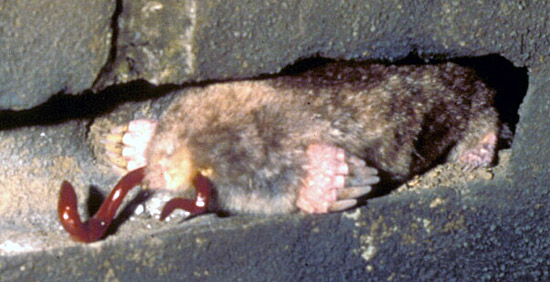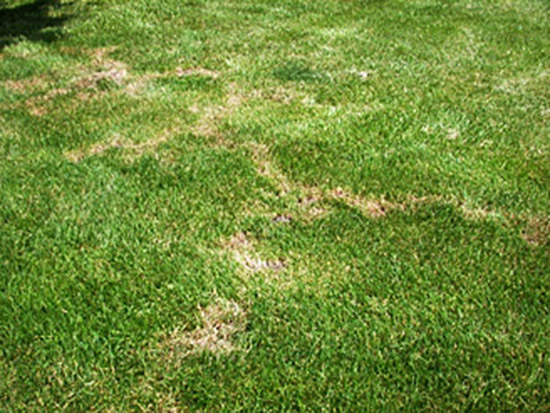Issue 3, May 15, 2017
Moles
Getting rid of moles is as easy as removing squirrels, and the end result is the same. Once the pesky creature is removed, nature steps in, and nature abhors a vacuum. That means another mole will take its place. Moles are a little different, but somewhat the same. You can battle and battle with the moles, feel you've won, and then find out another moves in.
Moles are carnivores not herbivores, which means they eat more meat and not plants. Plants are just a nuisance in the mole's hot pursuit of their next meal of earthworms, grubs and other soil creatures. They won't eat plants. They won't eat seeds. They won't eat bulbs. This is a key fact to remember.

Mole with earthworm.
Moles end up causing problems because they have to tunnel to find the earthworms, grubs and other soil creatures. So, they keep pushing through the soil, creating serpentine hills throughout the yard, with small feeding tunnels branching off one or two main ones. The tunnel becomes a hollow tube with roots dangling through the ceiling, exposed to the air, frantically trying to grab any bit of moisture. Since the only moisture in the air is humidity, the roots fail and the plant ends up wilting and dying. Usually, that's the turf. Moles will have a nest deep underground; a large mound of soil without a hole could be an indicator of a nest.

Mole feeding tunnels.
The other weird thing about moles is that they seldom congregate in packs or herds, or in the case of moles, a group called a "labour" or "labor." It may seem like hundreds of moles are in a lawn, but in reality there may be only a couple in early spring; the male (boar) mates with the female (sow) and a litter of 3-5 young are raised, and then depart on their own.
A mole is geared for the digging with large front paws, both with an extra thumblike appendage to help move soil. Because moles have a high metabolism, your typical mole has to eat approximately 80% of his or her body weight daily in order to stay alive. A mole doesn't want to compete with another mole for food.
Those who live near meadows, woods, or have lots of trees are more likely to be invaded by moles, as they are their native habitats. Those in tree-less subdivisions that last year were cornfields are less likely to experience mole damage especially in a heavy clay soil, but that's not a 100% guarantee. If a mole is around, any yard is fair game.
Controlling moles is more taxing. You're really relegated to traps, baits or repellents.
Most repellants are castor bean derivatives that showed some good results at Michigan State University. Unfortunately, after a rain or irrigation, the repellent is washed away, so reapplication is necessary. Growing castor beans themselves only is effective around the castor bean.
Mole baits usually contain bromethalin, sold as Talpirid. The chemical is imbedded in a worm-like bait. This bait is no longer a restricted-use product, but read and follow all the directions on the label. Gloves need to be worn when handling the bait and putting it in one of the main runs.
Just the concept of traps creates mixed emotions among animal lovers. The old fashioned traps essentially choked the mole. The new ones essentially spike/stab/guillotine the creatures. Place the trap in the straight main run and not the winding side feeding tunnels. If you can't tell which is which, stomp everything down and wait to see what pops up. That's usually the main tunnel. A trap will usually catch a mole within a day or two. (David Robson)
Author:
David Robson